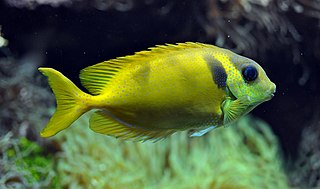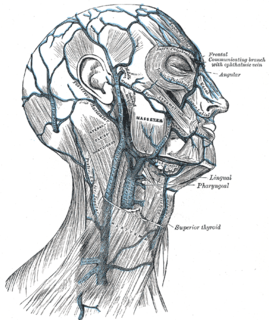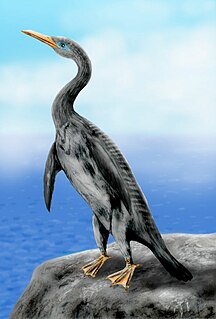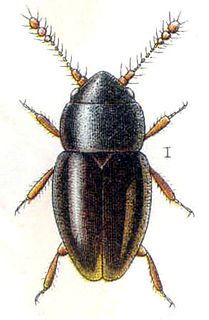
Nectocaris pteryx is a species of possible cephalopod known from the "early Cambrian" Emu Bay Shale and Chengjiang biota, the "middle Cambrian" Burgess Shale.

Neopterygii are a group of fish. Neopterygii means "new fins". Only a few changes occurred during their evolution from the earlier actinopterygians. They appeared sometime in the Late Permian, before the time of the dinosaurs. The Neopterygii were a very successful group of fish, because they could move more rapidly than their ancestors. Their scales and skeletons began to lighten during their evolution, and their jaws became more powerful and efficient. While electroreception and the ampullae of Lorenzini are present in all other groups of fish, with the exception of hagfish, Neopterygii have lost this sense, even if it has later been re-evolved within Gymnotiformes and catfishes, which possess nonhomologous teleost ampullae.

Megaloptera is an order of insects. It contains the alderflies, dobsonflies and fishflies, and there are about 300 known species.

Jinfengopteryx is a genus of maniraptoran dinosaur. It was found in the Qiaotou member of the Huajiying Formation of Hebei Province, China, and is therefore of uncertain age. The Qiaotou Member may correlate with the more well-known Early Cretaceous Yixian Formation, and so probably dates to around 122 Ma ago.

The pterygoid processes of the sphenoid, one on either side, descend perpendicularly from the regions where the body and the greater wings of the sphenoid bone unite.

The pterygoid plexus is a venous plexus of considerable size, and is situated between the temporalis muscle and lateral pterygoid muscle, and partly between the two pterygoid muscles.

Longipteryx is a genus of prehistoric bird which lived during the Early Cretaceous. It contains a single species, Longipteryx chaoyangensis. Its remains have been recovered from the Jiufotang Formation at Chaoyang in Liaoning Province, China. Apart from the holotype IVPP V 12325 - a fine and nearly complete skeleton — another entire skeleton and some isolated bones are known to date.

Pterodactyloidea is one of the two traditional suborders of pterosaurs, and contains the most derived members of this group of flying reptiles. They appeared during the middle Jurassic Period, and differ from the basal rhamphorhynchoids by their short tails and long wing metacarpals. The most advanced forms also lack teeth, and by the late Cretaceous, all known pterodactyloids were toothless. Many species had well-developed crests on the skull, a form of display taken to extremes in giant-crested forms like Nyctosaurus and Tupandactylus. Pterodactyloids were the last surviving pterosaurs when the order became extinct at the end of the Cretaceous Period, together with the non-avian dinosaurs and most marine reptiles.
Laopteryx is the name assigned to a pterosaur from the Upper Jurassic Morrison Formation of Wyoming, United States; it was originally thought to be a bird.
Cacibupteryx is a genus of rhamphorhynchid "rhamphorhynchoid" pterosaur from the middle-late Oxfordian-age Upper Jurassic Jagua Formation of Pinar del Río, Cuba.

Muzquizopteryx is a genus of pterodactyloid pterosaur from the Late Cretaceous of what is now Coahuila, Mexico.

Copepteryx is an extinct genus of flightless bird of the family Plotopteridae, endemic to Japan during the Oligocene living from 28.4—23 mya, meaning it existed for approximately 5.4 million years.

Ptiliinae is the largest subfamily of feather-winged beetles. About 80% of the described genera of these very tiny beetles are contained herein; however, many more genera and species await description.
Pteryx is a genus of beetles that is typically found in northern bogs in the Northern Hemisphere. They belong to the family Ptiliidae which is referred to as feather-winged beetles as the hindwings are narrow and feather-like. Like most of the rest of the family, Pteryx are very small and live in rotting vegetative matter. They prefer rotting wood and are generally found under the bark of rotting logs or stumps.

Pteryx UAV is a Polish Miniature UAV designed for civilian use, manufactured and sold by TriggerComposites. The machine can be classified both as flying RC model and pre-programmed vehicle. It has received a medal for innovative design in the category of micro-enterprises of the Podkarpacie region: Innowator Podkarpacia 2010.
Hauffiopteryx is an extinct genus of ichthyosaur known from Germany, Luxembourg and Somerset of the United Kingdom.

Eosinopteryx is an extinct genus of theropod dinosaurs known the late Jurassic period of China. It contains a single species, Eosinopteryx brevipenna.
Pterophocaena nishinoi is an extinct species of porpoise discovered in the Late Miocene Wakkanai Formation of Japan dating to 9.3–9.2 million years ago (mya), and may represent an intermediate phase between porpoises and dolphins. It is one of the oldest species discovered, after the Middle Miocene Loxolithax 16–14.8 mya and the Late Miocene Salumiphocaena 12.6–9 mya. The holotype specimen comprises a partial skeleton. The genus name derives from Ancient Greek pteryx, "wing," in reference to its unusually pronounced beak, and Latin phocaena, "porpoise." The species name honors the discoverer of the holotype, Takanobu Nishino.
Ambopteryx is a genus of scansoriopterygid dinosaur from the Oxfordian stage of the Late Jurassic of China. It is the second dinosaur to be found with both feathers and bat-like membranous wings. Yi, the first such dinosaur, was described in 2015 and is the sister taxon to Ambopteryx. The holotype specimen is thought to be a sub-adult or adult. The specimen is estimated to have had a body length of 32 centimetres (13 in) and a weight of 306 grams (0.675 lb). The genus includes one species, Ambopteryx longibrachium.

Fukuipteryx prima is a basal bird found in Early Cretaceous deposits from Japan's Kitadani Formation.













